Data on births presented in this release were obtained from the timely and late registered births at the Office of the City Civil Registrar of Pasay and submitted to the Office of the Civil Registrar General through the Philippine Statistics Authority – National Capital Region - Provincial Statistical Office V (PSA-NCR-PSO V). The information presented includes births by the usual residence of the mother that occurred from January to December 2023 based on data files received by the PSA - Civil Registration Service (CRS) from the PSOs and processed as of 31 August 2024. The figures presented herein are not adjusted for under registration.
Registered live births in Pasay City increased in 2023.
In 2023, Pasay City recorded 5,018 registered live births, a 5.1 percent increase from 2022. This marks the second year of modest recovery after sharp declines during the COVID-19 pandemic. From 2014 to 2018, births consistently exceeded 6,400, peaking at 6,918 in 2014. However, a downward trend began in 2019 and worsened during the pandemic, with a 16.0 percent drop in 2020 and 18.6 percent in 2021. Although increases were observed in 2022 and 2023, birth numbers remain about 27.5 percent lower than in 2014. The city reported a crude birth rate of 11.4, equivalent to around 11 births per 1,000 population or an average of 14 births per day. (See Figure 1)
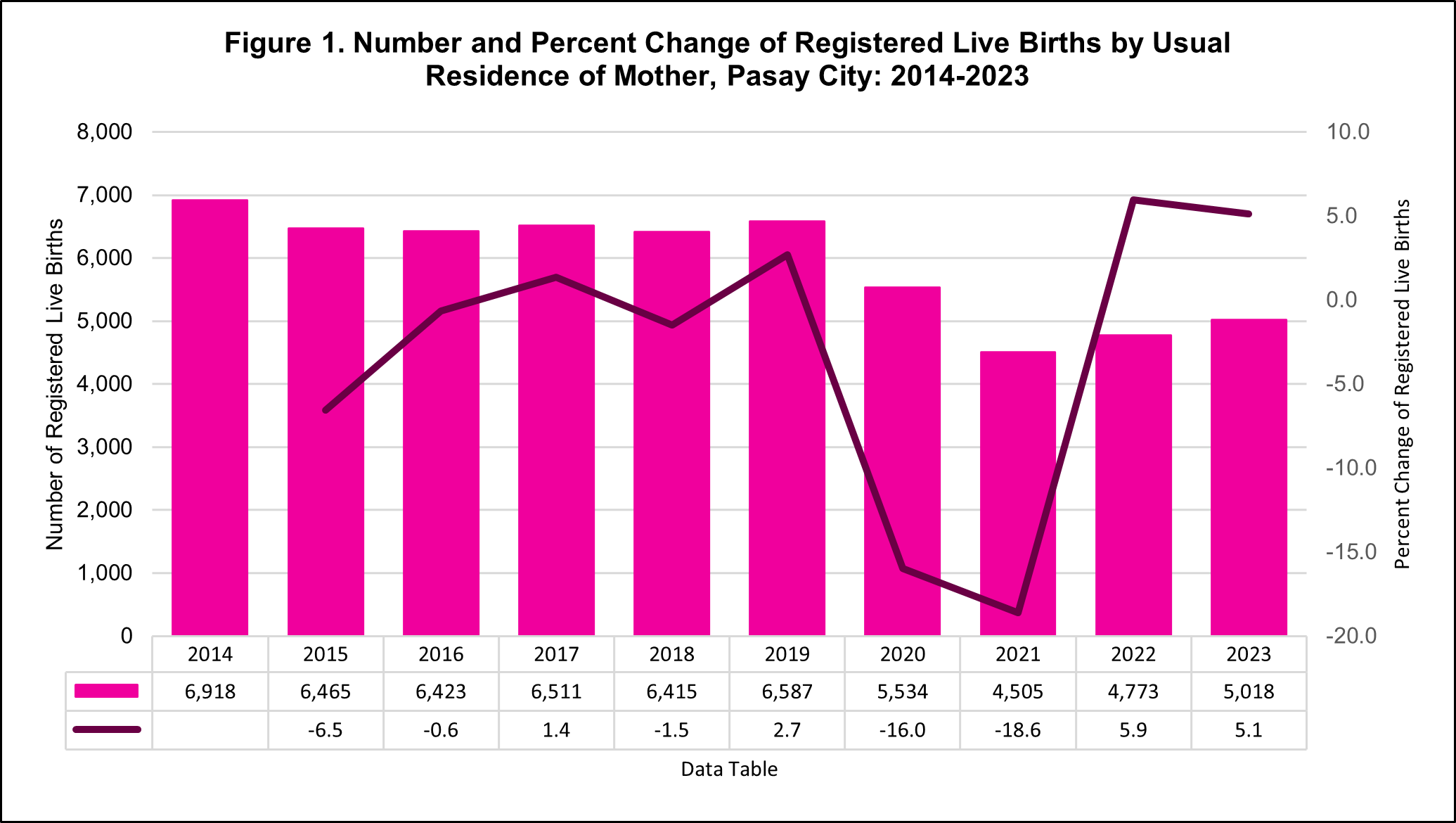
Source: Philippine Statistics Authority, Civil Registration Service, Vital Statistics Division
Male births outnumbered female births in the recorded data.
From January to December 2023, Pasay City recorded a continued predominance of male live births over female births, maintaining a demographic trend observed in previous years. A total of 2,619 male births were registered, comprising 52.2 percent of the total, while female births numbered 2,399 or 47.8 percent. This resulted in a sex ratio of 109 males for every 100 females. In 2022, a similar pattern was observed with 2,505 male births or 52.5 percent and 2,268 female births or 47.5 percent, yielding a slightly higher sex ratio of 110 males per 100 females. These consistent figures suggest a stable trend favoring male births. The slight fluctuation in the sex ratio, alongside a modest rise in total births in 2023, underscores a continuing demographic pattern in the city. (See Figures 2 and 3)
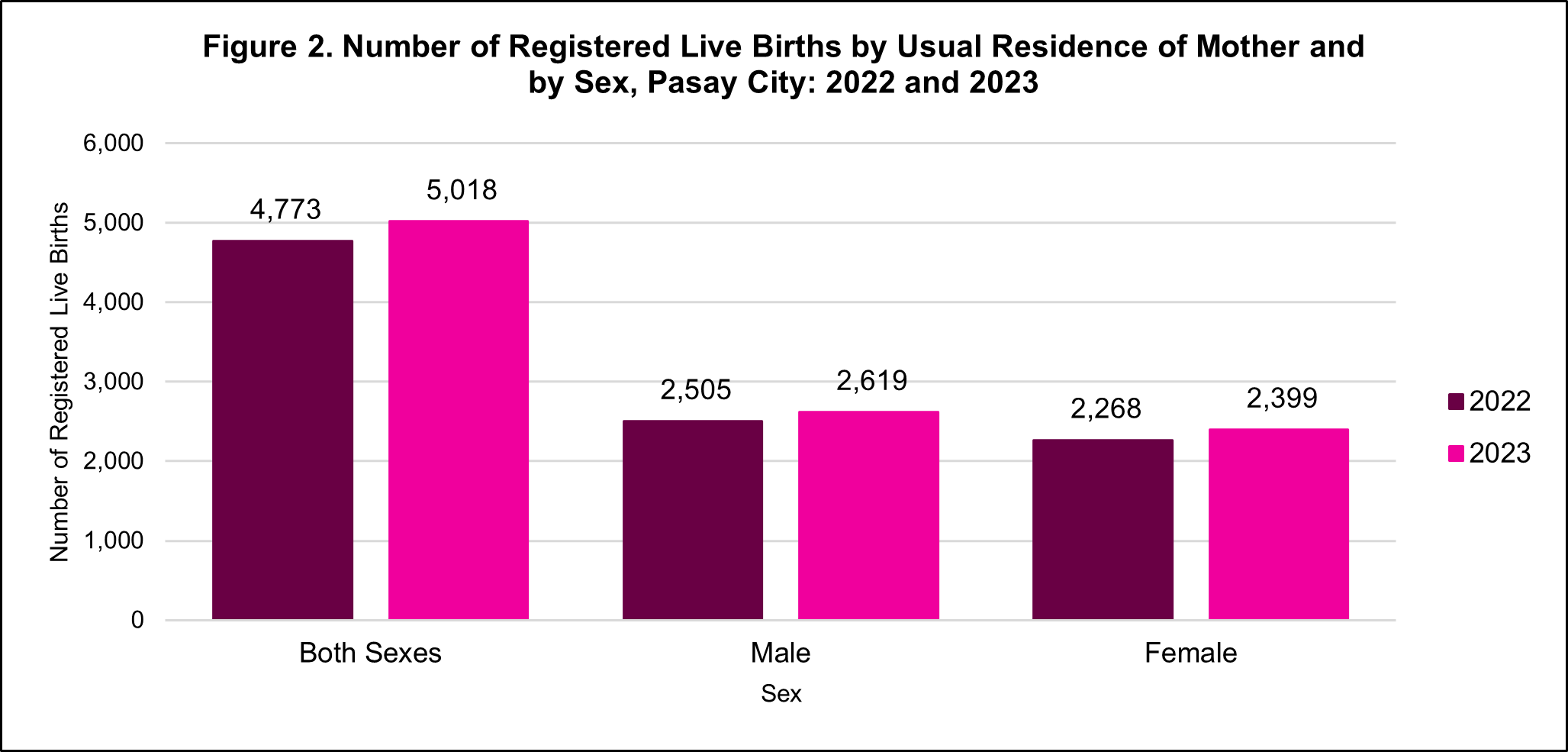
Source: Philippine Statistics Authority, Civil Registration Service, Vital Statistics Division
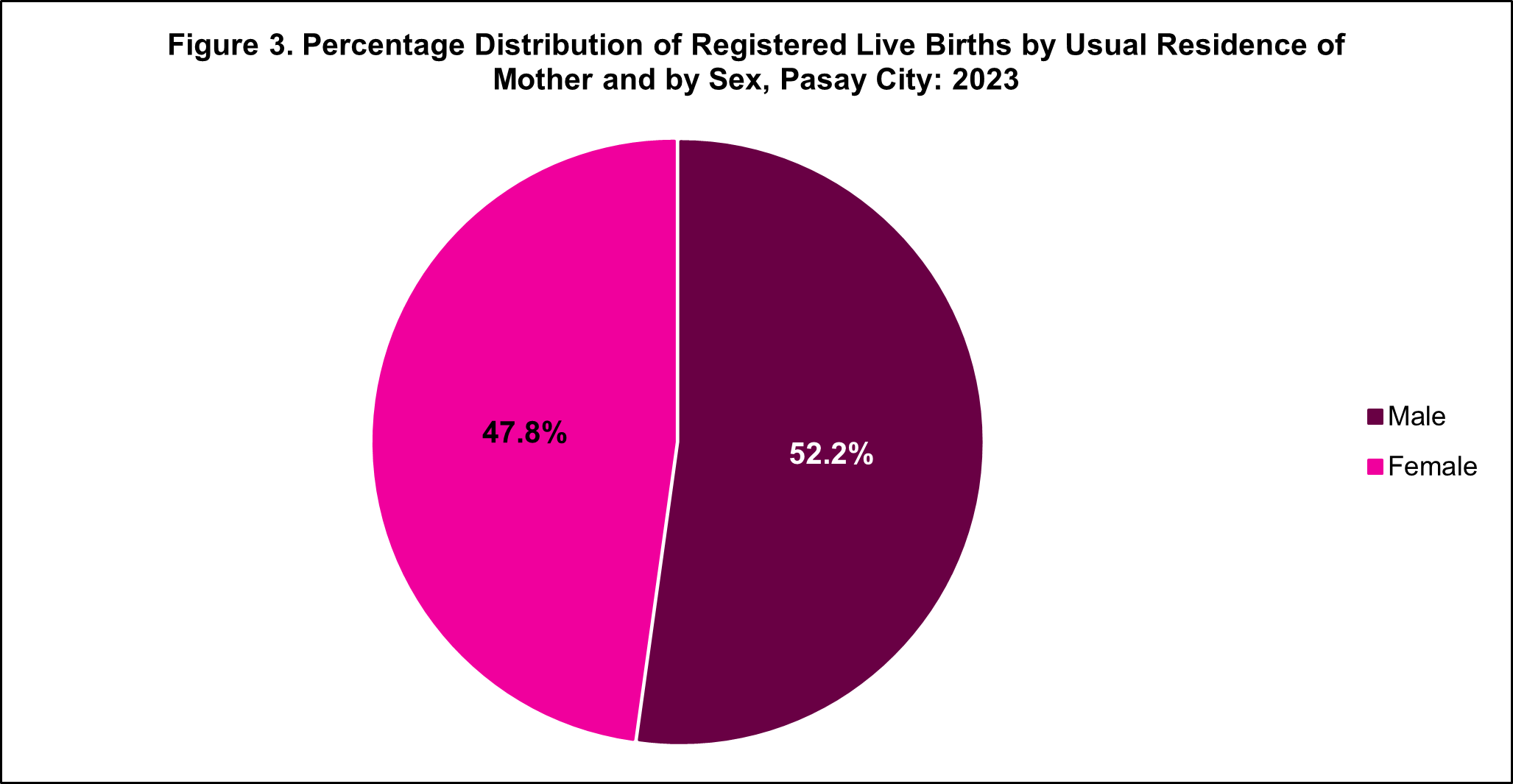
Source: Philippine Statistics Authority, Civil Registration Service, Vital Statistics Division
Most number of births were registered in October.
October emerged as the peak month for registered live births in Pasay City in 2023, recording 472 births, which accounted for 9.4 percent of the total annual count. This was closely followed by November with 456 births or 9.1 percent and September with 439 births or 8.7 percent. In contrast, April recorded the lowest number of live births, contributing only 7.1 percent to the yearly total. (See Figure 4)
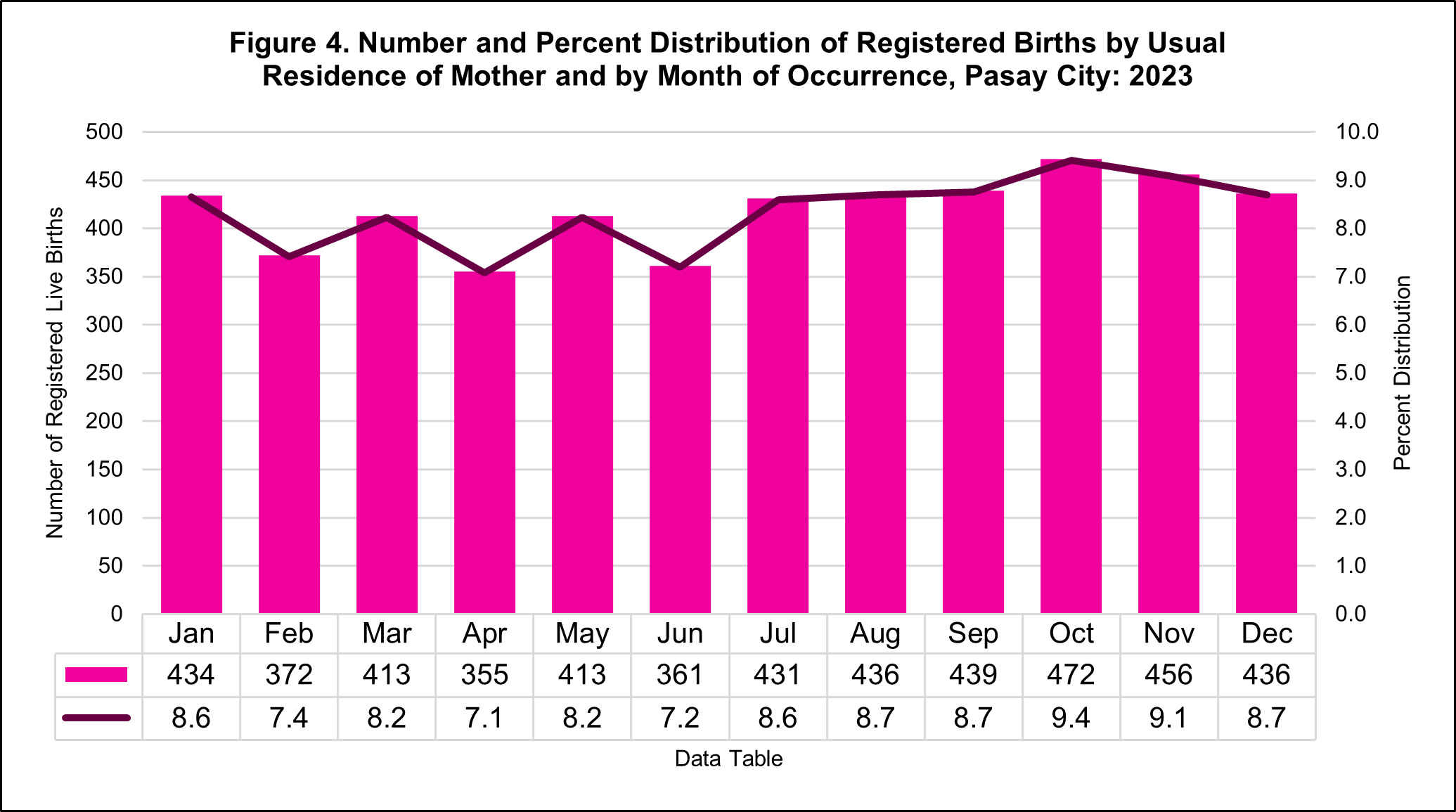
Source: Philippine Statistics Authority, Civil Registration Service, Vital Statistics Division
Proportion of birth deliveries attended by health professionals increased in 2023.
In 2023, 99.3 percent of registered live births in the city were attended by health professionals, reflecting a 0.2 percentage point increase from 99.1 percent in 2022. This uptick underscores improved access to, and growing trust in, professional maternal care services. Meanwhile, the proportion of births assisted by traditional birth attendants, or hilots, remained unchanged at 0.4 percent, suggesting a continued but limited reliance on non-medical birth assistance. Births categorized under “others” experienced a slight decline, decreasing from 0.5 percent in 2022 to 0.3 percent in 2023. (See Figure 5)
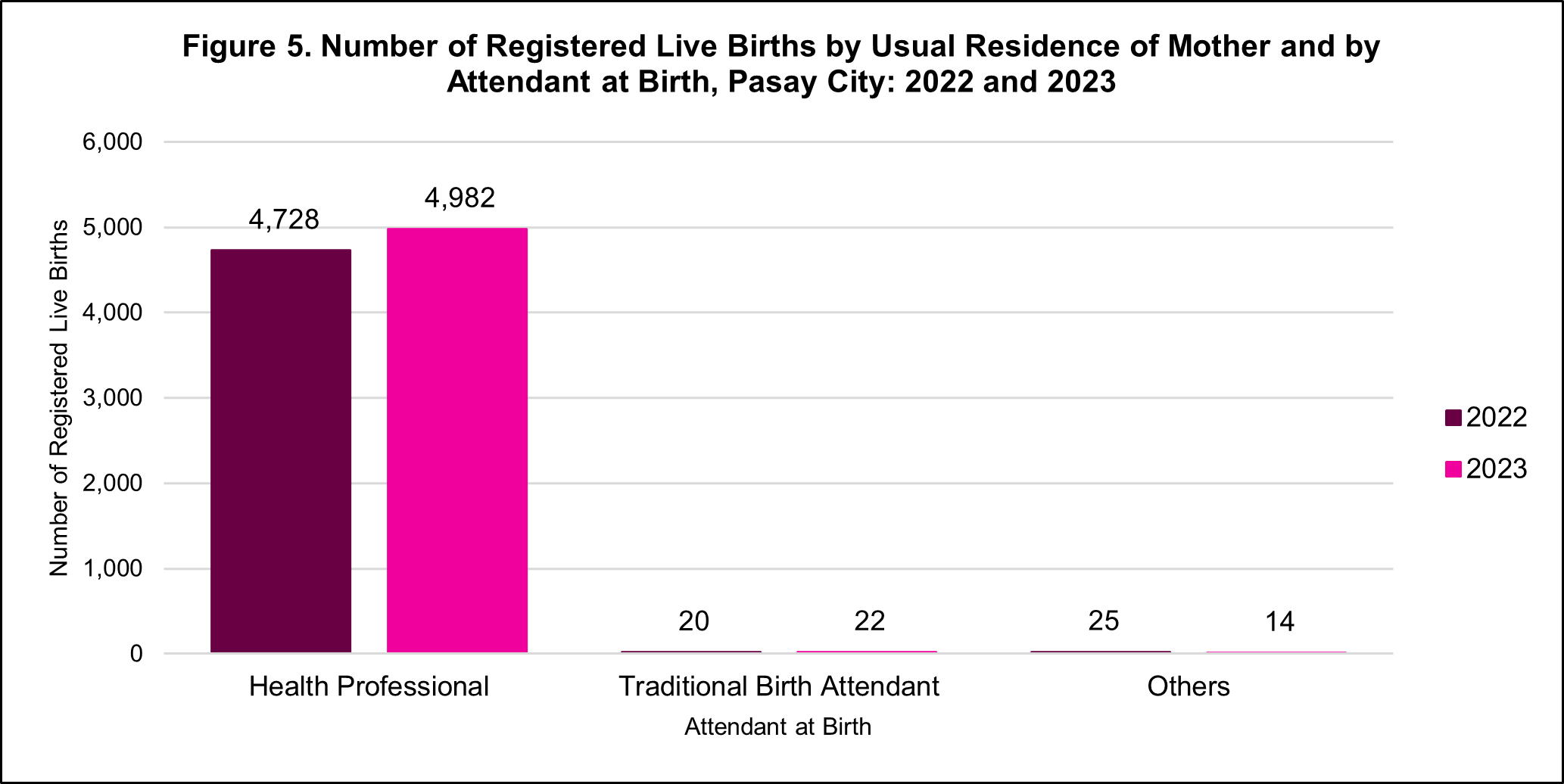
Source: Philippine Statistics Authority, Civil Registration Service, Vital Statistics Division
The majority of registered live births in Pasay City in 2023 were delivered under the supervision of health professionals, which include physicians, midwives, and nurses. Physicians accounted for the highest share, attending to 91.6 percent of total births. This was followed by midwives at 7.6 percent and nurses at 0.1 percent. In contrast, 0.4 percent of births were assisted by traditional birth attendants, while a minimal 0.3 percent were categorized under "others." (See Figure 6)
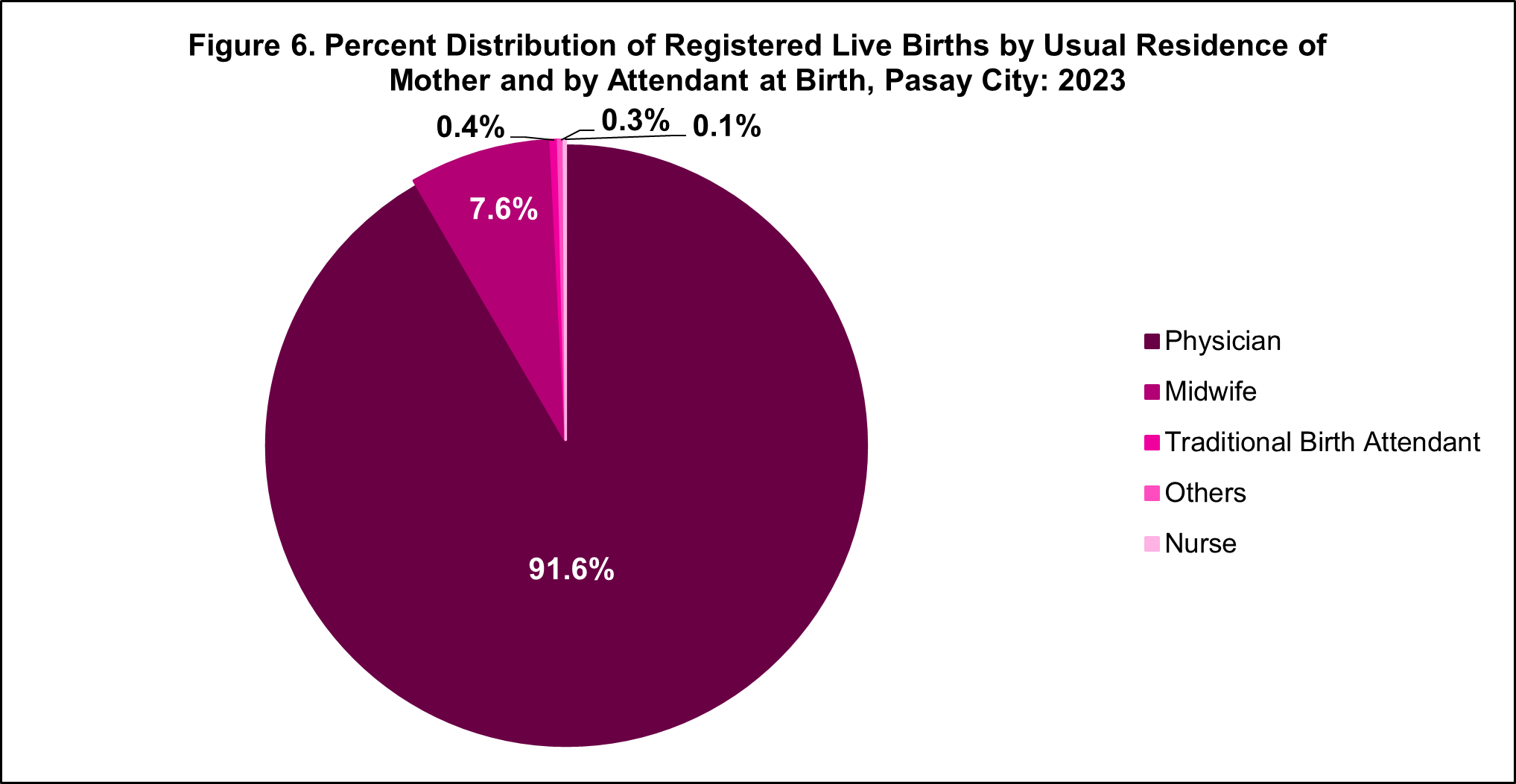
Source: Philippine Statistics Authority, Civil Registration Service, Vital Statistics Division
Rise in deliveries at health facilities observed in 2023.
In 2023, Pasay City reported that an impressive 99.0 percent of all births occurred in health facilities, including hospitals, birthing clinics, lying-in clinics, outpatient care centers, and other specialized establishments. This marks a notable increase from the 98.0 percent recorded in 2022, underscoring a sustained and positive shift toward facility-based childbirth. In contrast, only 0.9 percent of births took place at home, while a mere 0.1 percent occurred in other locations. (See Figures 7 and 8)

Source: Philippine Statistics Authority, Civil Registration Service, Vital Statistics Division
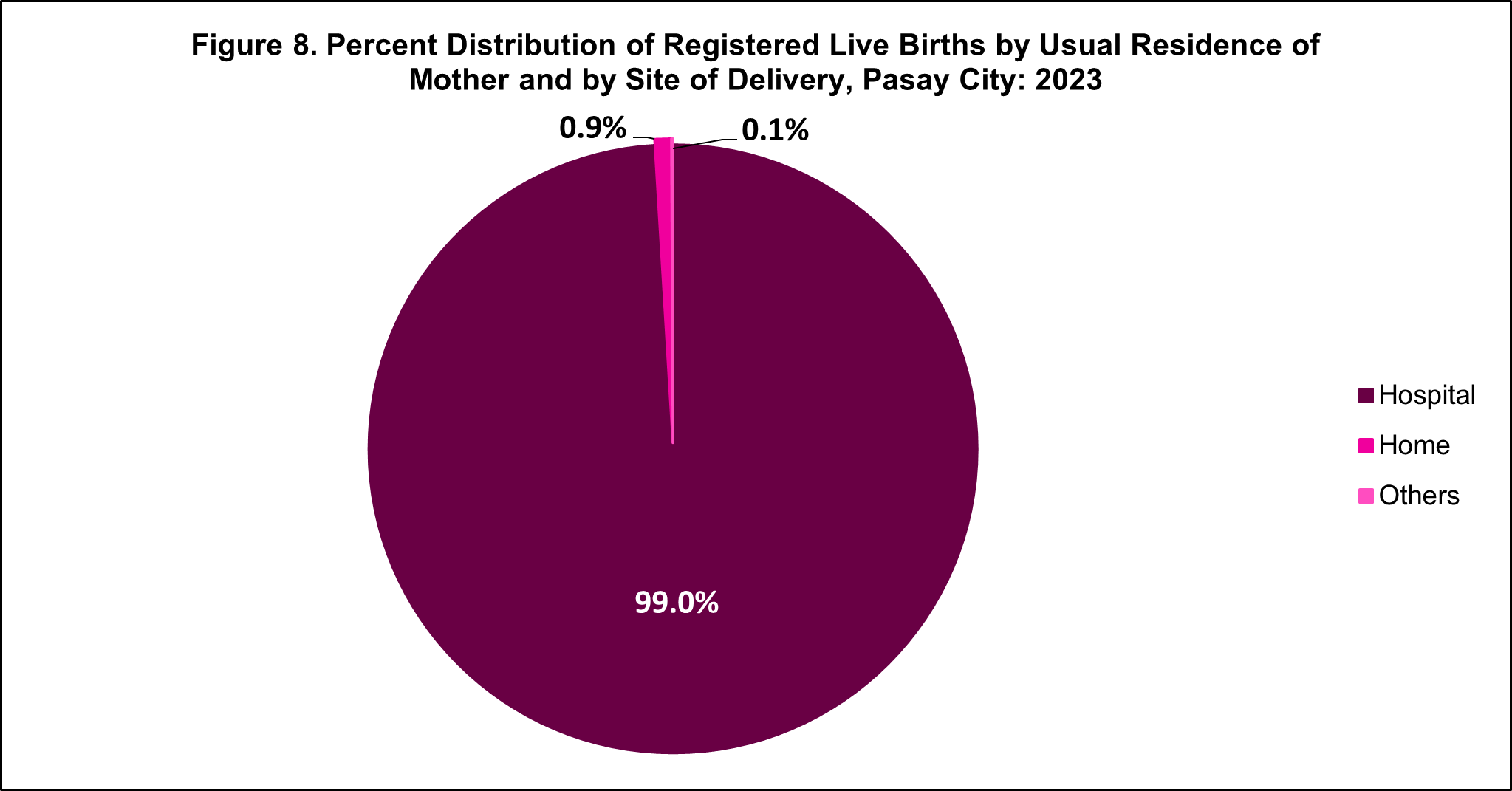
Source: Philippine Statistics Authority, Civil Registration Service, Vital Statistics Division
Most newborn babies weigh more than 2,500 grams.
The nutritional status of newborns is commonly assessed based on their birth weight, with the World Health Organization (WHO) defining low birth weight as less than 2,500 grams (5.5 pounds) at birth.
In 2023, Pasay City reported that the majority of newborns, specifically 4,361, or 86.9 percent of registered live births had a birth weight exceeding the low-birth-weight threshold, indicating generally favorable neonatal nutritional outcomes. Although this figure represents a slight decrease from 87.5 percent recorded in 2022, it nonetheless reflects a stable and positive trend in overall newborn health. Notably, the largest segment of these infants, totaling 1,904 or 37.9 percent, had birth weights within the range of 2,500 to 2,999 grams. (See Figure 9)
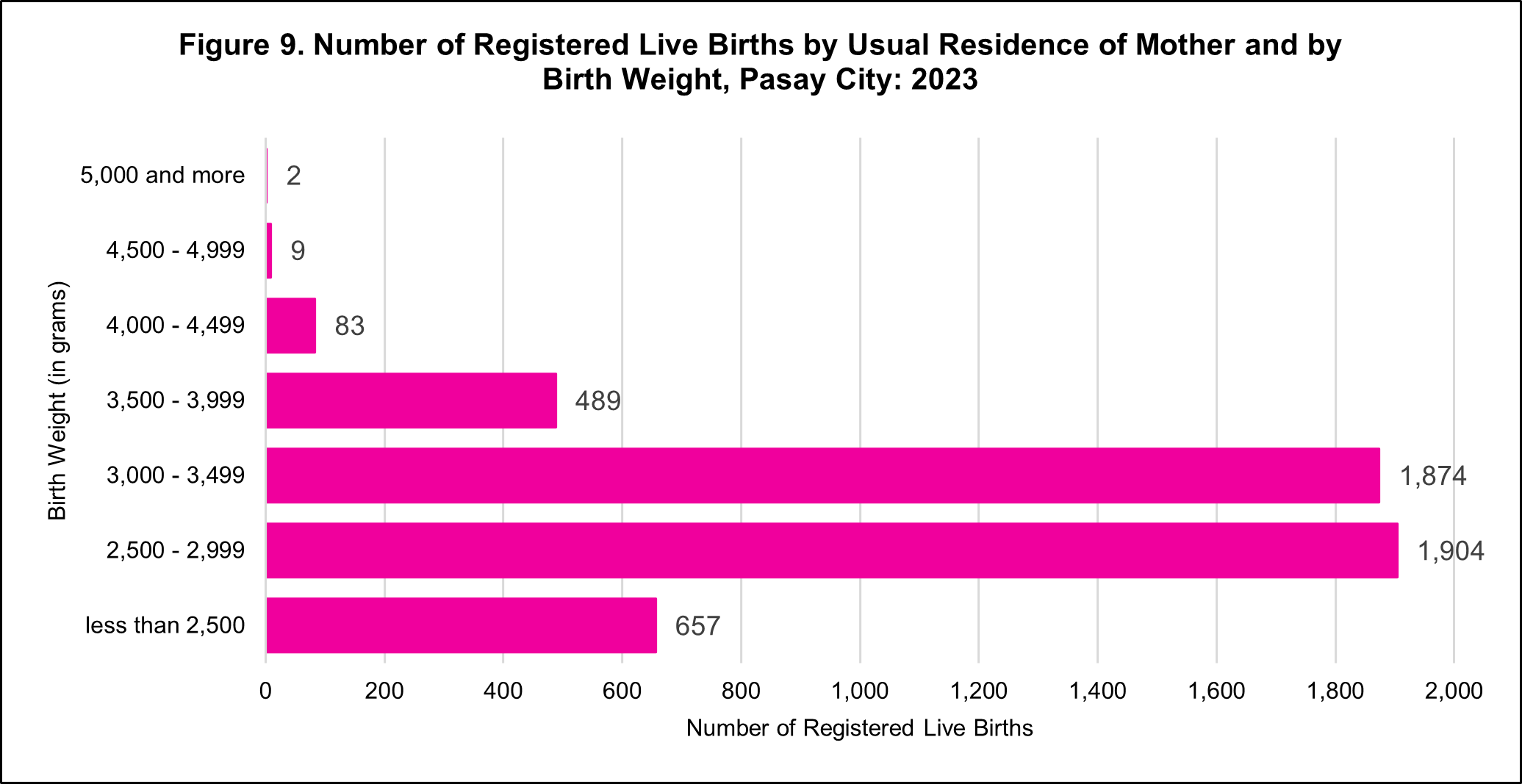
Source: Philippine Statistics Authority, Civil Registration Service, Vital Statistics Division
The majority of babies are born to father and mother aged 25-29 years old.
Pasay City reported a diverse demographic profile of parenthood in 2023, as reflected in the age distribution of mothers and fathers at the time of registered live births. The data reveal notable patterns in reproductive behavior and parental age dynamics across the city.
Most live births were to parents in their prime reproductive years. Individuals aged 25–29 comprised the largest share, accounting for 30.5 percent of mothers and 26.9 percent of fathers. This was followed closely by the 30–34 age group, which included 25.5 percent of mothers and 25.1 percent of fathers.
Notably, 6.8 percent of live births were to mothers under 20 years old, more than double the 2.8 percent recorded for adolescent fathers. This disparity underscores the continued prevalence of early motherhood over early fatherhood in the city.
In contrast, birth rates declined among older age groups. Parents aged 35–39 still represented a significant portion, with 12.3 percent of mothers and 15.6 percent of fathers. However, participation dropped in the 40–44 age group, with only 3.4 percent of mothers and 5.8 percent of fathers. Live births involving parents aged 45 and older were rare, accounting for just 0.1 percent of mothers and 3.5 percent of fathers.
It is also worth noting that while data on maternal age were complete, the age of the father was unreported in 5.9 percent of registered live births. (See Figure 10)
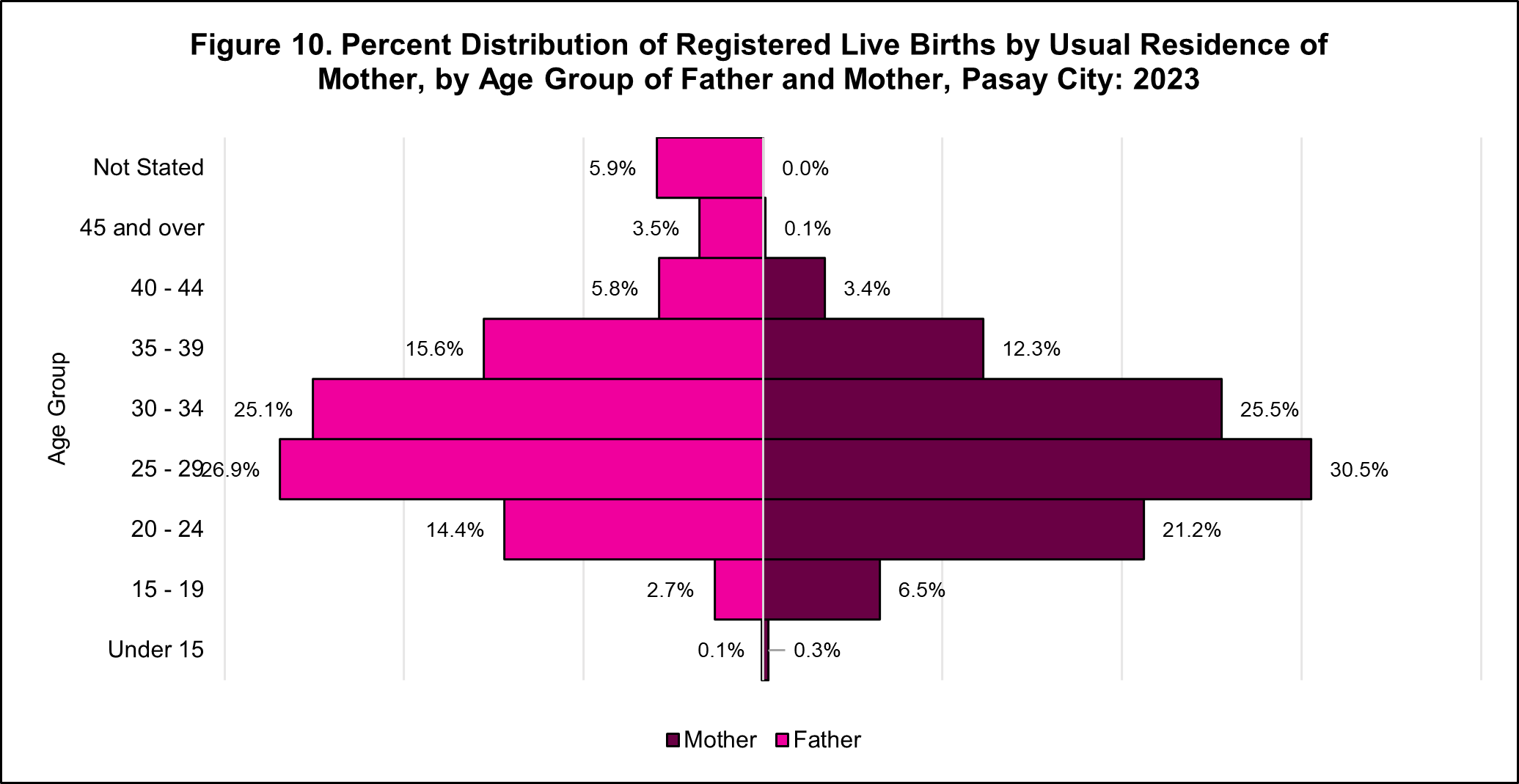
Source: Philippine Statistics Authority, Civil Registration Service, Vital Statistics Division
The median age of mothers at childbirth was 29 years old while for fathers, it was 31 years old. This means that half of the births in 2023 in Pasay City were to mothers and fathers who were at least 29 years old and 31 years old, respectively.
Those between the ages of 17 and younger and 35 years old and over are considered to be at "high risk" of pregnancy. This is because childbearing in these age groups is more likely to have complications during pregnancy and labor that may result in higher morbidity and mortality for both mother and child.
In 2023, approximately 6.8 percent of newborns were born to mothers younger than 20 years old, while around 15.9 percent were born to mothers aged 35 years and older. (See Figure 11)
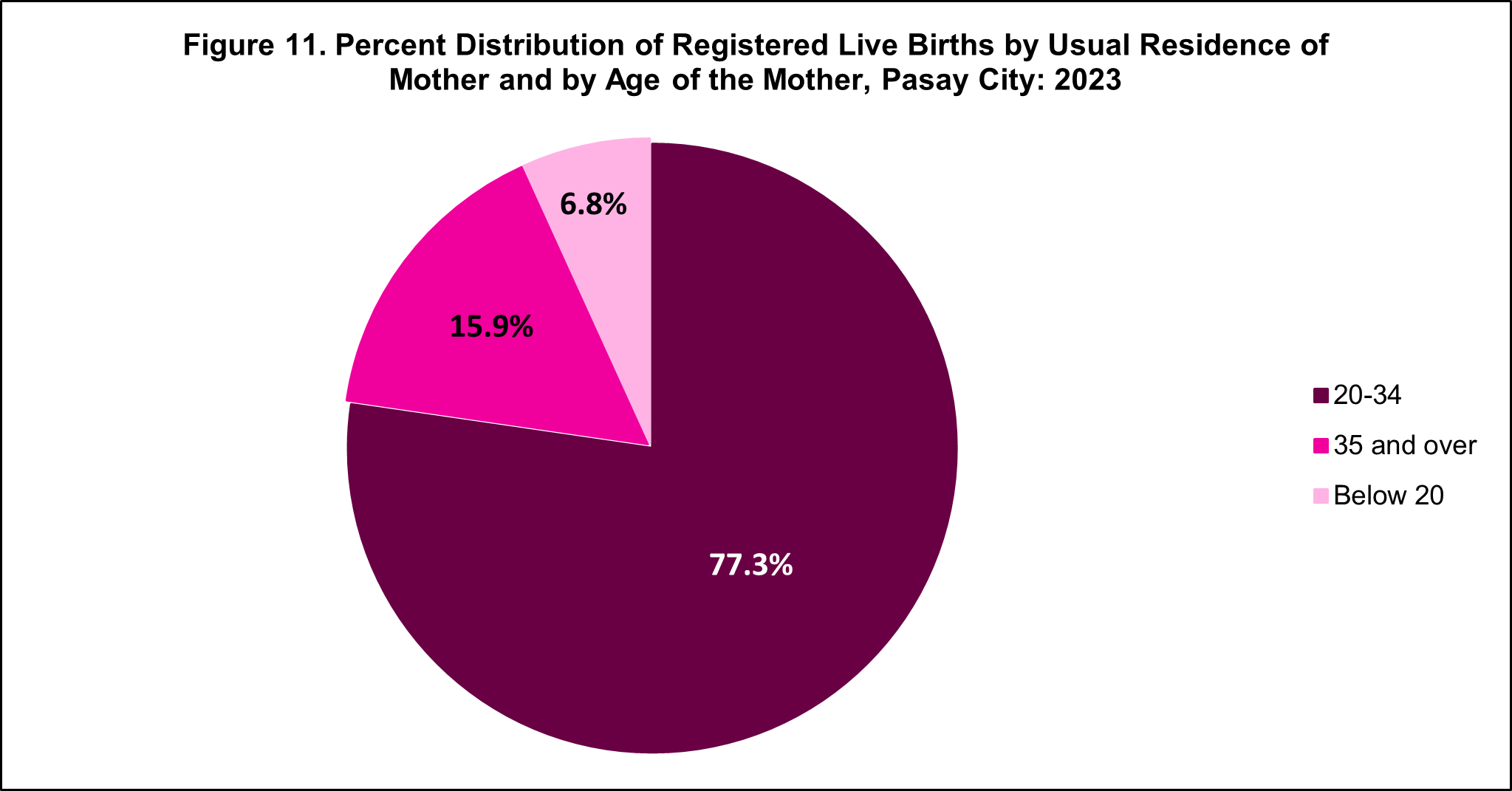
Source: Philippine Statistics Authority, Civil Registration Service, Vital Statistics Division
More than half of newborns were born to unmarried mothers.
The highest incidence of non-marital births in the city in 2023 was recorded among mothers aged 25–29, with 1,139 cases or 31.4 percent of the total. This was followed by mothers aged 20–24, who accounted for 968 cases or 26.7 percent, reflecting a notable share among younger women. Meanwhile, 764 cases or 21.1 percent were recorded among mothers aged 30–34, indicating a declining trend in this age group’s share compared to those in their twenties. (See Figure 12)
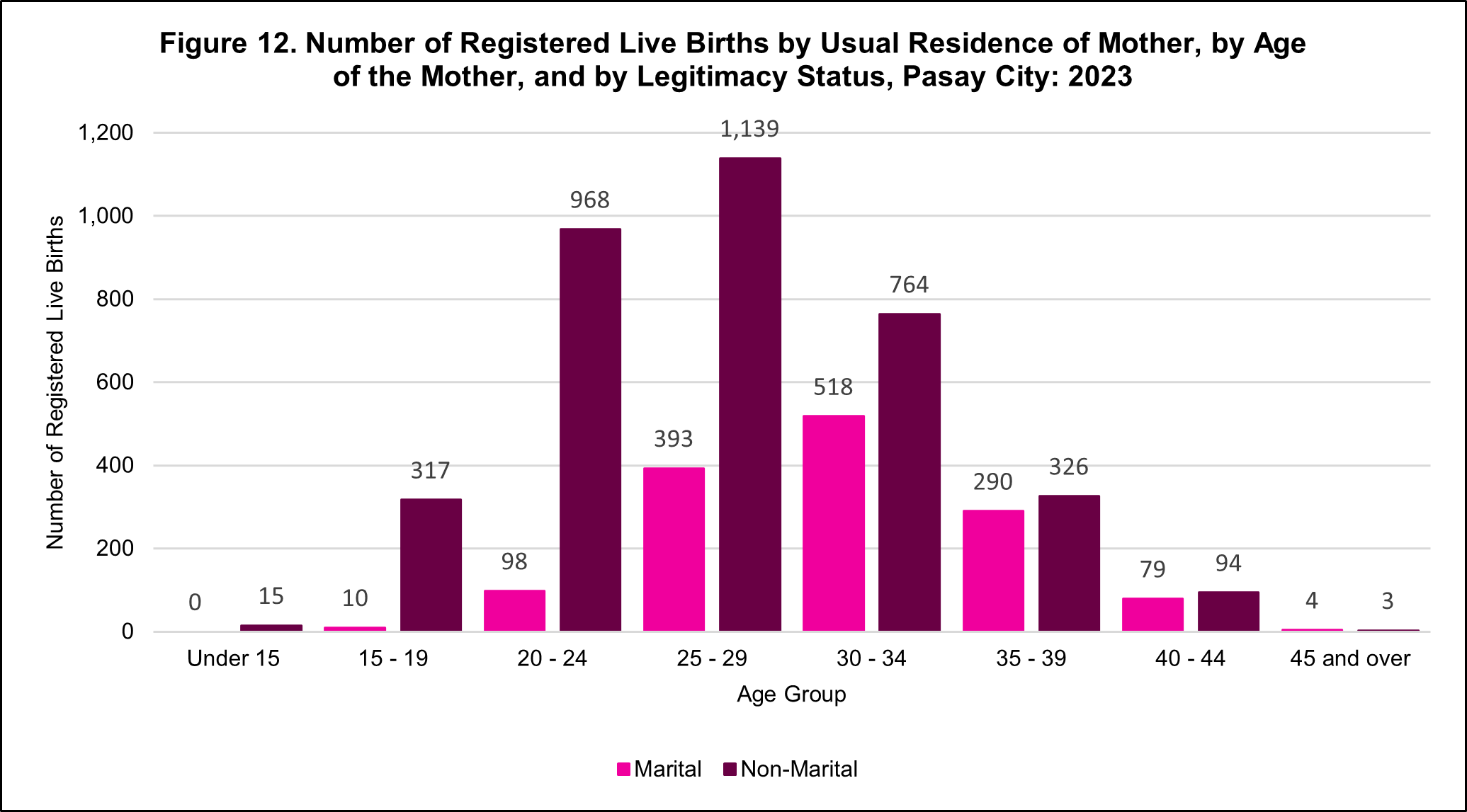
Source: Philippine Statistics Authority, Civil Registration Service, Vital Statistics Division
Moreover, in 2023, a significant majority of live births in the city were classified as non-marital. Out of the total registered births, 3,626 infants or equivalent to 72.3 percent were born out of wedlock, underscoring a prevailing trend of non-marital childbearing. In contrast, only 1,392 births, or 27.7 percent, were to legally married parents, highlighting a substantial disparity between non-marital and marital births during the year. (See Figure 13)
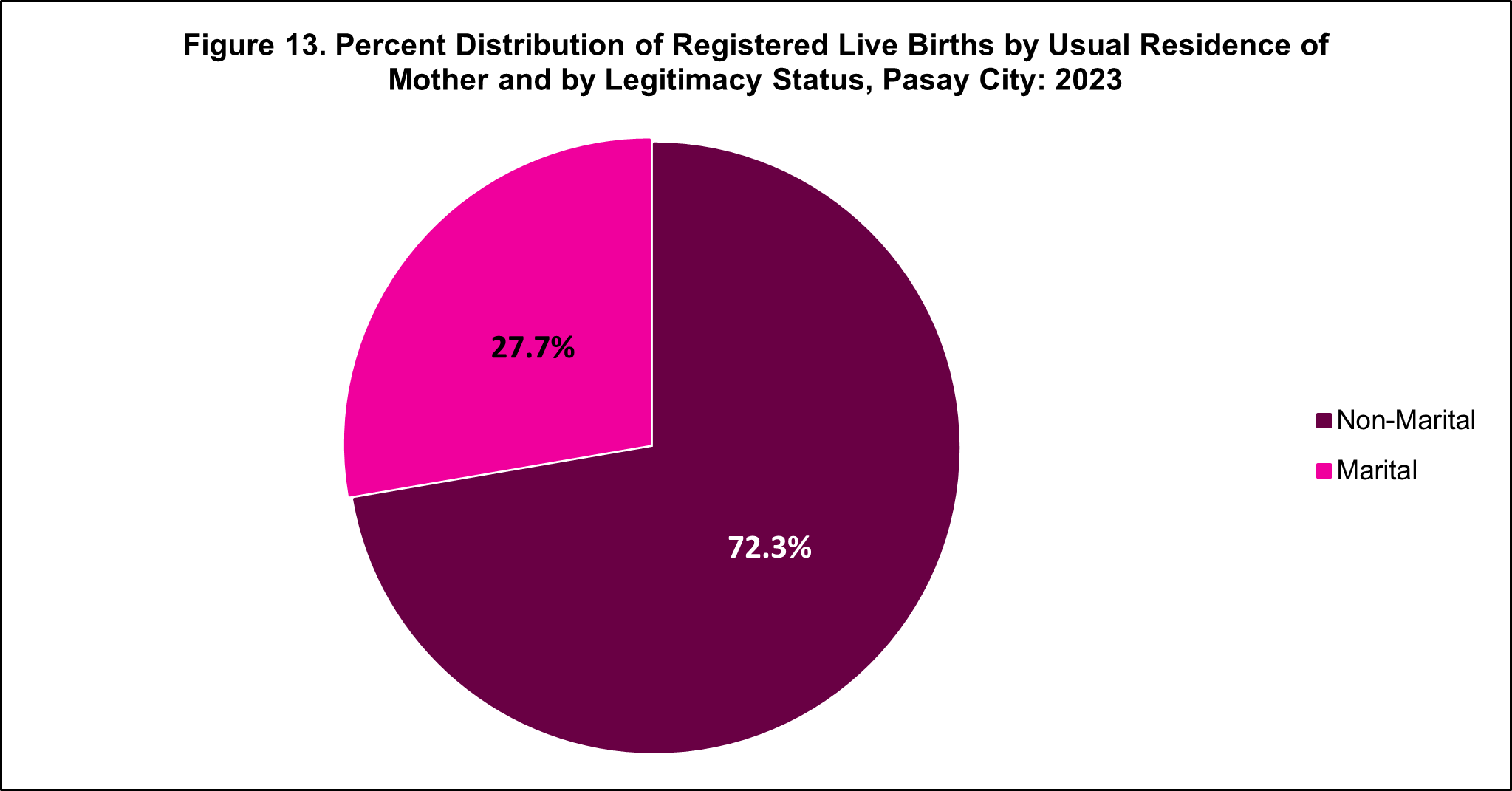
Source: Philippine Statistics Authority, Civil Registration Service, Vital Statistics Division
The city demonstrated notable age-related trends in birth legitimacy. Non-marital births were overwhelmingly prevalent among younger mothers, with rates at 100.0 percent for those under 15, 96.9 percent for ages 15–19, and 90.8 percent for ages 20–24. The trend began to shift at ages 25–29, where 25.7 percent of births occurred within marriage. Marital births increased to 40.4 percent among mothers aged 30–34 and 45.7 percent at ages 40–44, surpassing 50 percent by age 45 and above, suggesting growing legitimacy with maternal age. (See Figure 14)
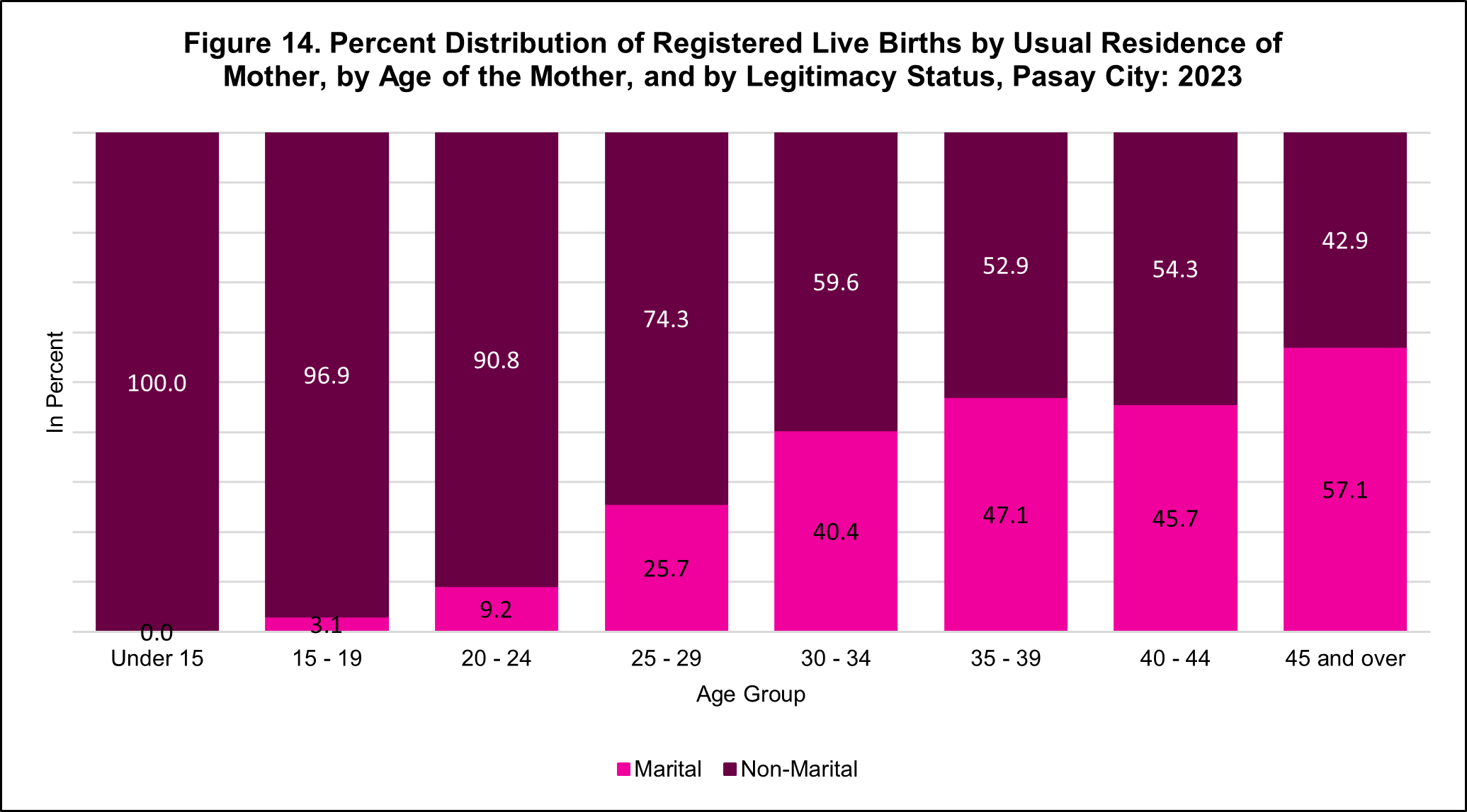
Source: Philippine Statistics Authority, Civil Registration Service, Vital Statistics Division
Almost 90 percent were registered on time.
The birth of a child shall be registered within thirty days from the time of birth to be considered a timely registration. In Pasay City, approximately nine of every ten registered births in 2023 were on time. (See Figure 15)
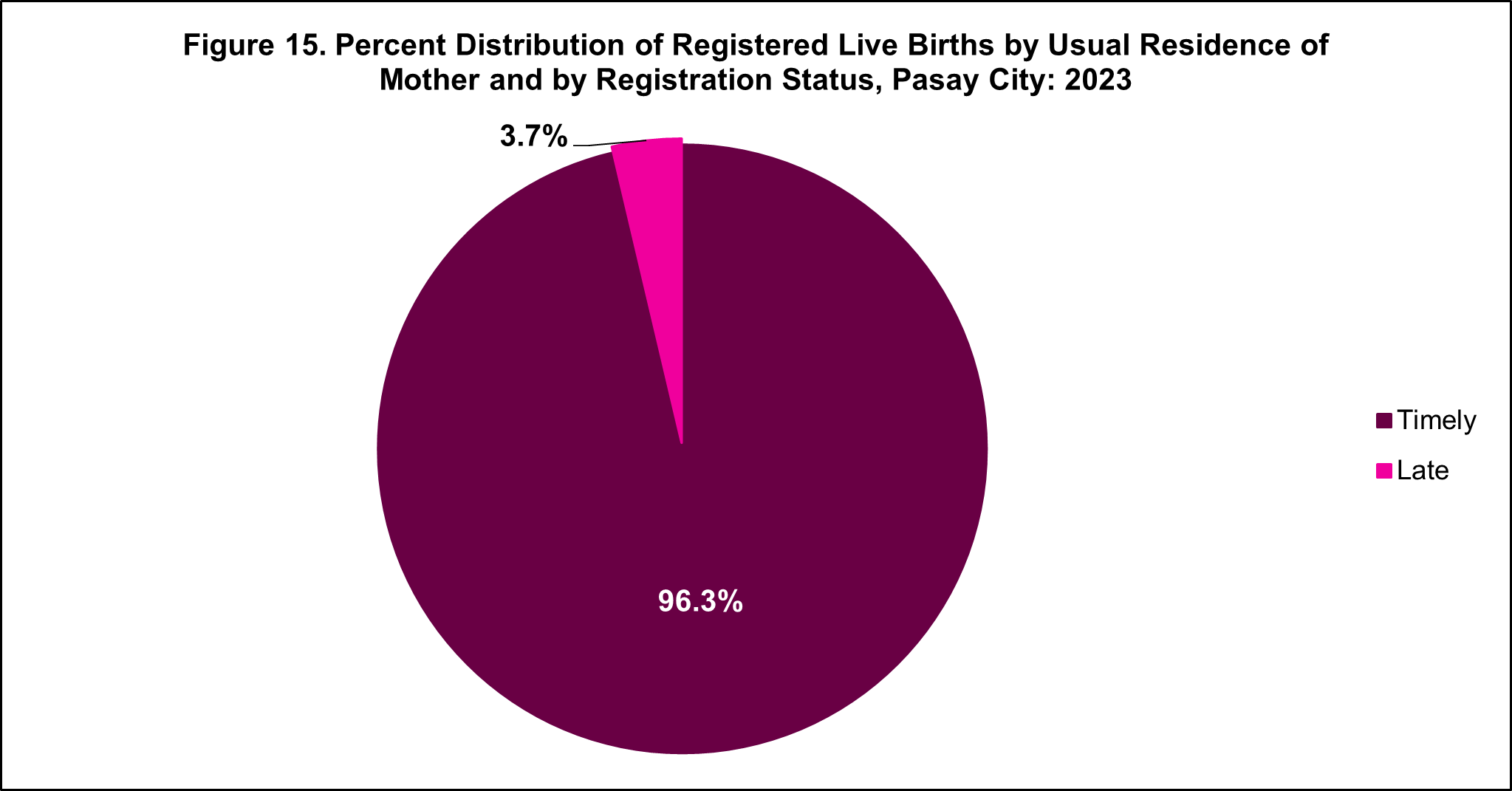
Source: Philippine Statistics Authority, Civil Registration Service, Vital Statistics Division
Technical Notes
Civil Registration is the recording in the appropriate civil registers, vital acts and events that affect the civil status of individuals.
Vital Statistics are derived from information obtained at the time when the occurrences of vital events and their characteristics are inscribed in a civil register.
Vital acts and events are the births, deaths, fetal deaths, marriages, and all such events that have something to do with an individual's entrance and departure from life together with the changes in civil status that may occur to a person during his lifetime. Recording of these events in the civil register is known as vital or civil registration and the resulting documents are called vital records.
• Live Birth - is the complete expulsion or extraction from its mother of a product of conception, irrespective of the duration of pregnancy, which, after such separation, breathes or shows any other evidence of life, such as beating of the heart, pulsation of umbilical cord, or definite movement of the voluntary muscles. Whether or not the umbilical cord has been cut, or the placenta is attached; each product of such a birth is considered live born.
• Sex Ratio - refers to the number of males per one hundred females.
• Usual Residence - refers to the place where the person habitually or permanently resides.
• Crude Birth Rate - The ratio between the number of live births in a population during a given year and the total mid-year population for the same year, usually multiplied by 1,000
For more details, please visit www.psa.gov.ph
ESTRELLA R. VARGAS
Chief Statistical Specialist
Attachments:
1. Table 1. Number and Percent Change of Live Births by Usual Residence of Mother and by Sex, Pasay City: 2014-2023
2. Table 2. Number and Percent Distribution of Live Births by Usual Residence of Mother, by Month, and by Sex, Pasay City: 2023
3. Table 3. Number and Percent Distribution of Live Births by Usual Residence of Mother and by Attendant at Birth, and by Sex, Pasay City: 2023
4. Table 4. Number and Percent Distribution of Live Births by Usual Residence of Mother, by Site of Delivery, and by Sex, Pasay City: 2023
5. Table 5. Number and Percent Distribution of Live Births by Usual Residence of Mother, by Birth Weight, and by Sex, Pasay City: 2023
6. Table 6. Number and Percent Distribution of Live Births by Usual Residence of Mother, by Age of the Mother, by Sex, and by Legitimacy Status: Pasay City: 2023
7. Table 7. Number and Percent Distribution of Live Births by Usual Residence of Mother, by Age of the Father, by Sex, and by Legitimacy Status: Pasay City: 2023
8. Table 8. Number of Live Births by Usual Residence of Mother, by Month, and by Registration Status: Pasay City: 2023
